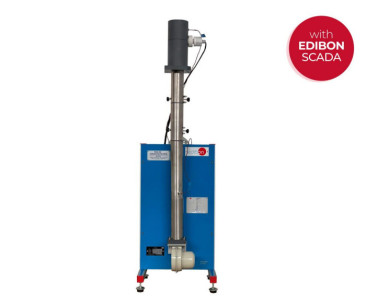TSTCC 热传递研究系列,由计算机(PC)控制
創新系統
The Computer Controlled Heat Transfer Series, "TSTCC", has been designed by EDIBON to study and compare different types of heat transfer on a small scale.
化验室
相關新聞
一般說明
The Computer Controlled Heat Transfer Series, "TSTCC", has been designed by EDIBON to study and compare different types of heat transfer on a small scale. It allows a wide range of heat transfer demonstrations and study the factors affecting and problems associated with different types of heat transfer.
The minimum supply consists of two main elements: Control Interface for TSTCC (Common for all "TXC" type modules), "TSTCC/CIB",and at least one of the required elements described below.
Each heat transfer module can be individually connected to the Control Interface for TSTCC (Common for all "TXC" type modules) "TSTCC/CIB", which provides the necessary electrical supply and instrumentation connections for the study of the different types of heat transfer.
This Computer Controlled Unit is supplied with the EDIBON Computer Control System (SCADA), and includes: The Control Interface Box + a Data Acquisition Board + Computer Control, Data Acquisition and Data Management Software Packages, for controlling the process and all parameters involved in the process.
配饰
线性热传导设备(用于TSTCC)
径向热传导设备(用于TSTCC)
辐射传热设备(用于TSTCC)
自由与强制对流及辐射组合传热设备(用于TSTCC)
扩展表面传热设备(用于TSTCC)
温度测量中辐射误差设备(用于TSTCC)
非稳态传热设备(用于TSTCC)
液体和气体热导率设备(用于TSTCC)
自由和强制对流传热设备(用于TSTCC)
三轴传热设备(用于TSTCC)
用于TSTCC的(金属对金属)传热设备
用于TSTCC的陶瓷传热设备
用于TSTCC的绝缘材料传热设备
練習和指導練習
手册中包含的指导实践练习
Practices to be done with the Linear Heat Conduction Module (TXC/CL):
- Conduction through a simple bar.
- Conduction through a compound bar.
- Determination of the thermal conductivity "k" of different materials (conductors and insulators).
- The thermal conductivity properties of insulators may be found by inserting paper or other elements between the heating and cooling sections.
- Insulation effect.
- Determination of the thermal contact resistance Rtc.
- Effect of the crossing sectional area.
- Understanding the use of the Fourier equation in determining rate of heat flow through solid materials.
- Sensors calibration.
Practices to be done with the Radial Heat Conduction Module (TXC/CR):
- Radial conduction.
- Determination of the thermal conductivity "k".
- Determination of the thermal contact resistance Rtc.
- Insulation effect.
- Understanding the use of the Fourier equation in determining rate of heat flow through solid materials.
- Sensors calibration.
Practices to be done with the Radiation Heat Transfer Module (TXC/RC):
- Inverse of the distant square law for the radiation.
- Stefan Boltzmann Law.
- Emission power I.
- Emission power II.
- Kirchorff Law.
- Area factors.
- Inverse of the distant square law for the light.
- Lambert´s Cosine Law.
- Lambert Law of Absorption.
- Sensors calibration.
Practices to be done with the Combined Free and Forced Convection and Radiation Module (TXC/CC):
Practices to be done with the Extended Surface Heat Transfer Module (TXC/SE): Practices to be done with the Radiation Errors in Temperature Measurement Module (TXC/ER): Practices to be done with the Unsteady State Heat Transfer Module (TXC/EI): Practices to be done with the Thermal Conductivity of Liquids and Gases Module (TXC/LG): Practices to be done with the Free and Forced Convection Heat Transfer Module (TXC/FF): Practices to be done with the Three Axes Heat Transfer Module (TXC/TE): Practices to be done with the Metal to Metal Heat Transfer Module (TXC/MM): Practices to be done with the Ceramic Heat Transfer Module (TXC/TC): Practices to be done with the Insulating Material Heat Transfer Module (TXC/TI):
与该单位进行更多实际操作
- Many students view results simultaneously. To view all results in real time in the classroom by means of a projector or an electronic whiteboard.
- Open Control, Multicontrol and Real Time Control. This unit allows intrinsically and/or extrinsically to change the span, gains, proportional, integral, derivative parameters, etc, in real time.
- The Computer Control System with SCADA and PID Control allow a real industrial simulation.
- This unit is totally safe as uses mechanical, electrical and electronic, and software safety devices.
- This unit can be used for doing applied research.
- This unit can be used for giving training courses to Industries even to other Technical Education Institutions.
- Control of the TSTCC unit process through the control interface box without the computer.
- Visualization of all the sensors values used in the TSTCC unit process.
- By using PLC-PI additional 19 more exercises can be done.
- Several other exercises can be done and designed by the user.
配套设备
线性热传导设备(用于TSTCC)
径向热传导设备(用于TSTCC)
辐射传热设备(用于TSTCC)
自由与强制对流及辐射组合传热设备(用于TSTCC)
扩展表面传热设备(用于TSTCC)
温度测量中辐射误差设备(用于TSTCC)
非稳态传热设备(用于TSTCC)
液体和气体热导率设备(用于TSTCC)
自由和强制对流传热设备(用于TSTCC)
三轴传热设备(用于TSTCC)
用于TSTCC的(金属对金属)传热设备
質量

售後服務

 Cookies首选项
Cookies首选项






















